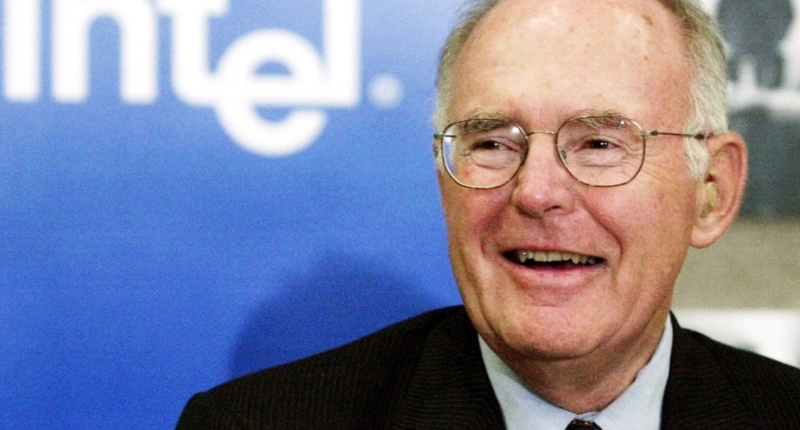Gordon Moore, co-founder of Intel and the creator of Moore’s Law, passed away at the age of 91. Moore co-founded Fairchild Semiconductor, a division of Fairchild Camera and Instrument. He later co-founded Intel and played a key role in the development of the microchip and the personal computer industry. Moore’s Law predicted that the number of transistors on a chip would double roughly every two years, a revision he made from his initial prediction of every year in 1975. Moore was also known for his philanthropy, having established the Gordon and Betty Moore Foundation with his wife in 2000. The foundation has given over $5.1 billion to beneficiaries such as the Tech Museum of Innovation and the Alameda County Medical Center. Moore was also an avid outdoorsman and was particularly interested in fishing. He will be remembered for his contribution to the tech industry and his dedication to philanthropy and conservation.
Silicon Valley Pioneer and Intel Co-founder Gordon Moore Passes Away at 94
Gordon Earle Moore, the co-founder of Intel Corp. and Fairchild Semiconductor, passed away on Friday at the age of 94. Moore, a Silicon Valley pioneer, was renowned for his contributions to microchip technology and his famous law, which predicted inevitable advancements in chip technology.
Moore’s involvement in the growth of Intel made him one of the wealthiest individuals globally and inspired numerous tech entrepreneurs across the world. Despite his success, Moore remained a down-to-earth and modest individual, finding joy in fishing trips in the wilderness. He was also widely praised for his philanthropic activities, which saw him donate much of his wealth to environmental and other causes.
Born on January 3, 1929, in San Francisco, Moore grew up in Pescadero and Redwood City, where he developed an interest in science, experimenting with a neighbor’s chemistry set as a teenager. His fascination with science led him to earn a doctorate in chemistry and physics from the California Institute of Technology in 1954. Although his studies did not include any business training, he went on to co-found one of the most influential tech companies globally.
Moore, in a 1994 article about his life, acknowledged that he was not a natural-born entrepreneur, but rather an “accidental entrepreneur.” After applying for a management position at Dow Chemical, which was considering establishing a research laboratory in California, he was rejected due to his lack of management experience. He eventually landed a job at Johns Hopkins University’s Applied Physics Laboratory, where he became concerned about the cost of the lab scientists’ publications, which he calculated at $5 a word.
In 1956, he joined William Shockley’s Mountain View startup, which was developing affordable silicon transistors. Although Lawrence Livermore Laboratory offered him a job, he declined, not wanting to participate in the laboratory’s nuclear-blast studies.
Moore’s legacy lives on through his contributions to the growth and development of Intel and the advancement of chip technology. His passing marks the end of an era and a significant loss to the tech industry.
Gordon Moore: From Fairchild Semiconductor to Intel
Gordon Moore was a co-founder of both Intel Corp. and Fairchild Semiconductor, companies that revolutionized the tech industry. In 1956, Moore joined William Shockley’s Mountain View startup, which was developing inexpensive silicon transistors. However, morale at the company quickly deteriorated due to Shockley’s sometimes abrasive idiosyncrasies, and Moore and seven co-workers quit a year later to form Palo Alto chip maker Fairchild Semiconductor. Moore became research director and co-founder Robert Noyce co-invented the microchip, which transformed the tech industry, though they didn’t initially recognize its implications. By the late 60s, Fairchild had 30,000 employees and was generating $150 million in annual sales.
However, when Noyce was passed over for the CEO’s job, he left the company, and Moore left with him in 1968. With an investment of less than $3 million and a single-page business plan, they started NM Electronics in Mountain View, which was later renamed Intel and became headquartered in Santa Clara. During his tenure, Intel became a global tech powerhouse, and Moore became a legendary figure in the tech industry.
Moore’s Law
Much of Moore’s fame is attributable to what has become known as Moore’s Law. In a 1965 Electronics Magazine article, Moore predicted that the number of tiny transistors squeezed onto chips would roughly double every year, which would lead to technological wonders such as home computers, automatic controls for automobiles, and personal portable communications equipment. He later revised his prediction to every two years in 1975, which has generally proven prophetic. Moore’s Law is still regarded as a fundamental principle in the tech industry.
Intel’s Growth
Intel began by making memory chips and then microprocessors that serve as the brains of most personal computers. Its stock market value peaked at nearly half a trillion dollars in 2000, and it is still the world’s largest chipmaker and the fourth biggest revenue generator in Silicon Valley. Moore served as Intel’s executive vice president initially, and he became the president and CEO in 1975, and later, the chairman and CEO. He remained CEO until 1987 and was named chairman emeritus in 1997.
Conclusion
Gordon Moore’s contributions to the growth and development of the tech industry are immeasurable. His co-founding of Fairchild Semiconductor and Intel transformed the industry, and his prediction of Moore’s Law has proven prophetic. Despite his success, Moore remained a down-to-earth and modest individual, finding joy in fishing trips in the wilderness. He was also widely praised for his philanthropic activities, which saw him donate much of his wealth to environmental and other causes. His passing marks the end of an era and a significant loss to the tech industry.
The Legacy of Gordon Moore
Gordon Moore was a co-founder of Intel Corp. and Fairchild Semiconductor, as well as a legend in Silicon Valley. Moore’s contribution to the growth of the tech industry is immeasurable. He is most renowned for his work on Moore’s Law, a prediction he made and later revised that the number of transistors squeezed onto chips would double every year, which has generally proven prophetic. In 1965, he predicted that this would lead to technological wonders such as home computers, automatic controls for automobiles, and personal portable communications equipment. However, the soft-spoken Moore was embarrassed by the attention he received due to his formula.
Intel’s Growth and Philanthropy
Moore served as Intel’s executive vice president initially, and he became the president and CEO in 1975, and later, the chairman and CEO. During his tenure, Intel became a global tech powerhouse, and its stock market value peaked at nearly half a trillion dollars in 2000. While the company’s share price has fallen, it is still the world’s largest chipmaker and the fourth biggest revenue generator in Silicon Valley.
Despite his success, Moore was known for his self-deprecating humor and down-to-earth sagacity. He acknowledged his mistakes, such as laying off thousands of employees when the economy went south, getting involved in the short-lived digital watch business, and failing to jump at the chance to become a personal computer maker.
Moore became astonishingly rich from his stock in Intel, estimating his worth to be $26 billion by 2000. However, he gave away much of his wealth and established the Gordon and Betty Moore Foundation in 2000. The foundation has given more than $5.1 billion to finance environmental conservation, science, and Bay Area causes, such as the Tech Museum of Innovation and the Alameda County Medical Center.
Love for Nature
Moore had a deep love for nature, becoming increasingly disheartened by civilization’s relentless intrusion into once-pristine places. He was particularly alarmed by what he and his wife saw during their many fishing trips outside of the U.S. Moore was a Republican and grew dismayed at the loss of the Bay Area’s once-vast agricultural areas.
Conclusion
Gordon Moore’s legacy is one of innovation, philanthropy, and love for nature. He co-founded Intel and Fairchild Semiconductor, which transformed the tech industry. His prediction of Moore’s Law has become a fundamental principle in the tech industry, and his philanthropic activities have benefited many organizations. Despite his success, Moore remained modest, acknowledging his mistakes and his luck in being at the beginning of a major industry. His passing marks the end of an era and a significant loss to the tech industry.
Gordon Moore, Co-founder of Intel and Philanthropist, Dies at 94
Gordon Moore, the iconic co-founder of Intel, passed away at the age of 94 on March 11th. Moore was a legend in Silicon Valley for his role in launching the microchip revolution and creating Intel, one of the world’s largest chip makers. He was also known for his philanthropy, donating much of his wealth to environmental and other causes.
The Early Years of Gordon Moore
Moore was born in San Francisco on January 3rd, 1929, and raised in Pescadero and Redwood City. He earned a doctorate in chemistry and physics from the California Institute of Technology in 1954. However, his education didn’t include business training, and he initially struggled to start a company.
Co-founding Intel and Fairchild Semiconductor
Moore and seven co-workers left Fairchild Semiconductor to form Palo Alto chip maker Fairchild Semiconductor. The company hit a technological home run when one of the founders, Robert Noyce, co-invented the microchip. Moore became Intel’s executive vice president, then president and CEO in 1975, and later chairman and CEO. During his involvement with the company, Intel became a global tech powerhouse and the world’s biggest chip maker.
Moore’s Law
Moore’s prediction about the number of tiny transistors squeezed onto chips would roughly double every year is known as Moore’s Law. The prediction has proven prophetic, and it forecasted the direction of technological innovation for the future. His formula has acquired epic stature in the lore of Silicon Valley.
Philanthropy and Conservation
Using $5 billion worth of Intel stock, Moore and his wife, Betty, established the Gordon and Betty Moore Foundation to help finance environmental conservation, science, and Bay Area causes. The foundation has given more than $5.1 billion to beneficiaries ranging from the Tech Museum of Innovation to the Peninsula Open Space Trust to the Alameda County Medical Center.
Final Thoughts
Moore was known for his self-deprecating humor and down-to-earth sagacity. He was also an avid outdoorsman who often kept his cell phone off to avoid bothersome calls. He will be remembered as a pioneer of technology, an inspiration to entrepreneurs, and a philanthropist committed to preserving the environment.
Don’t miss interesting posts on Famousbio









